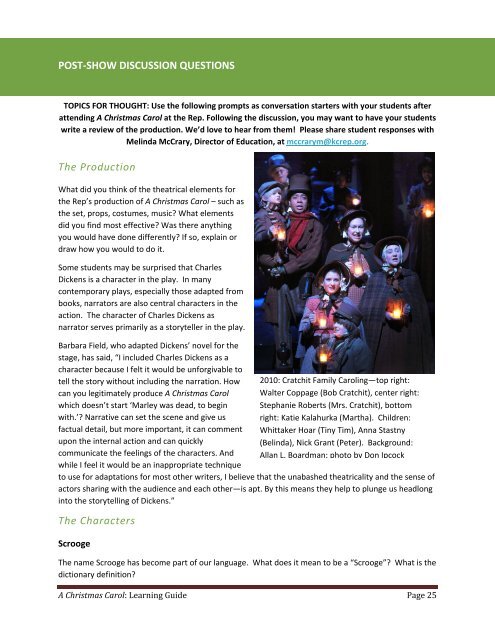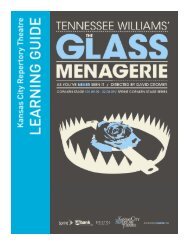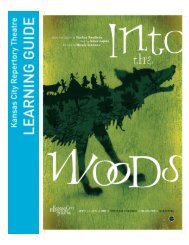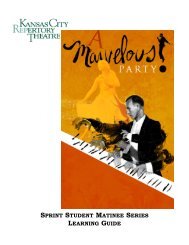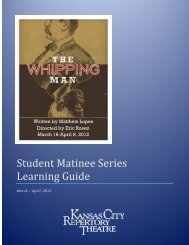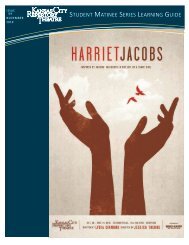A Christmas Carol - The Kansas City Repertory Theatre
A Christmas Carol - The Kansas City Repertory Theatre
A Christmas Carol - The Kansas City Repertory Theatre
Create successful ePaper yourself
Turn your PDF publications into a flip-book with our unique Google optimized e-Paper software.
POST‐SHOW DISCUSSION QUESTIONS<br />
TOPICS FOR THOUGHT: Use the following prompts as conversation starters with your students after<br />
attending A <strong>Christmas</strong> <strong>Carol</strong> at the Rep. Following the discussion, you may want to have your students<br />
write a review of the production. We’d love to hear from them! Please share student responses with<br />
Melinda McCrary, Director of Education, at mccrarym@kcrep.org.<br />
<strong>The</strong> Production<br />
What did you think of the theatrical elements for<br />
the Rep’s production of A <strong>Christmas</strong> <strong>Carol</strong> – such as<br />
the set, props, costumes, music? What elements<br />
did you find most effective? Was there anything<br />
you would have done differently? If so, explain or<br />
draw how you would to do it.<br />
Some students may be surprised that Charles<br />
Dickens is a character in the play. In many<br />
contemporary plays, especially those adapted from<br />
books, narrators are also central characters in the<br />
action. <strong>The</strong> character of Charles Dickens as<br />
narrator serves primarily as a storyteller in the play.<br />
Barbara Field, who adapted Dickens’ novel for the<br />
stage, has said, “I included Charles Dickens as a<br />
character because I felt it would be unforgivable to<br />
tell the story without including the narration. How<br />
can you legitimately produce A <strong>Christmas</strong> <strong>Carol</strong><br />
which doesn’t start ‘Marley was dead, to begin<br />
with.’? Narrative can set the scene and give us<br />
factual detail, but more important, it can comment<br />
upon the internal action and can quickly<br />
communicate the feelings of the characters. And<br />
while I feel it would be an inappropriate technique<br />
to use for adaptations for most other writers, I believe that the unabashed theatricality and the sense of<br />
actors sharing with the audience and each other—is apt. By this means they help to plunge us headlong<br />
into the storytelling of Dickens.”<br />
<strong>The</strong> Characters<br />
Scrooge<br />
2010: Cratchit Family <strong>Carol</strong>ing—top right:<br />
Walter Coppage (Bob Cratchit), center right:<br />
Stephanie Roberts (Mrs. Cratchit), bottom<br />
right: Katie Kalahurka (Martha). Children:<br />
Whittaker Hoar (Tiny Tim), Anna Stastny<br />
(Belinda), Nick Grant (Peter). Background:<br />
Allan L. Boardman; photo by Don Ipcock<br />
<strong>The</strong> name Scrooge has become part of our language. What does it mean to be a “Scrooge”? What is the<br />
dictionary definition?<br />
A <strong>Christmas</strong> <strong>Carol</strong>: Learning Guide Page 25


